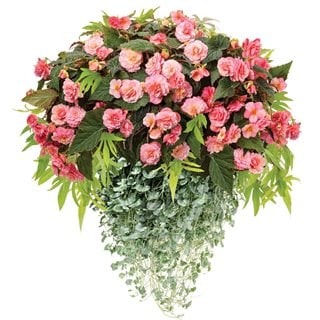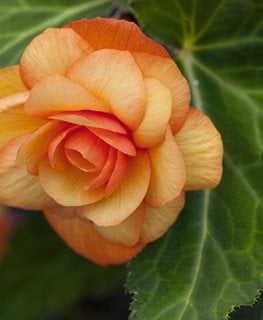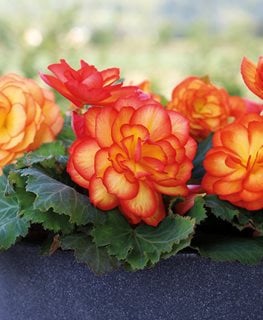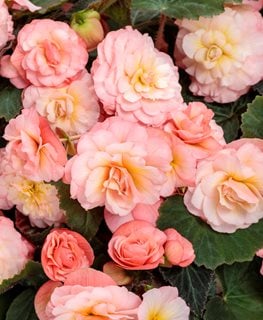How to Grow Showstopping Tuberous Begonias
Dress up a shady garden, porch or patio with these colorful, rose-like blooms
Nonstop® Fire tuberous begonia. Photo by: Proven Winners.
It’s hard to beat tuberous begonias for bringing brilliant, long-lasting color to shady gardens. These eye-catching tropicals produce loads of large, lightly fragrant flowers that bloom continuously throughout the summer and fall, right up until the first nip of frost. As container plants, tuberous begonias are second to none because of their long bloom season and lush foliage.
Many varieties have flowers that cascade or trail, putting on a spectacular show when planted in hanging baskets and window boxes. But you can also find upright forms ideal for planting in garden beds and borders, as long as you provide good drainage and shelter from scorching afternoon sun.
On this page: Basics | Planting | Care and Maintenance | Pictures | FAQ's
On this page:
- BASICS
- PLANTING TUBEROUS BEGONIAS
- TUBEROUS BEGONIA CARE
- TUBEROUS BEGONIA PICTURES
- FREQUENTLY ASKED QUESTIONS
BASICS
Botanical name:
Begonia × tuberhybrida
Hardiness Zones:
9-11; in colder zones (2-8), grow as annuals or overwinter the tubers indoors
Origin:
Tropical regions of South America and southern Africa
Growth habit:
Upright or trailing, depending on the variety
Height/spread:
Up to 18 inches tall (for upright types), trailing or spreading up to 24 inches
Exposure:
Shade to partial sun
Bloom time:
From late spring until frost. Once plants start blooming, they can flower continuously for up to four months.
Flowers:
Single, double, or ruffled flowers up to 6 inches across come in shades of pink, yellow, orange, red, white, or bicolors, some with picotee edges.
Foliage:
Leaves may be various shades of green, maroon, or chocolate brown and are usually pointed, with serrated edges.
Fun fact:
Tuberous begonias are monoecious, which means they bear both male and female flowers on the same plant. They are produced in clusters of three, with two smaller female flowers next to the larger, usually double, male flower.
PLANTING TUBEROUS BEGONIAS

Begonia tubers. Photo by: Stanislav71 / Shutterstock
When to plant:
Although begonia tubers can be planted directly outdoors in spring after the danger of frost has passed, they may not bloom until late summer or early fall in northern areas of the country. To speed things up, you can start the tubers indoors about 8 to 12 weeks before the last frost date in your area so they have time to develop before being moved outside. Once the weather warms up and nighttime temperatures are consistently above 50 F, the tubers can be transplanted into the garden.
Where to plant:
Grow in dappled sun or bright shade, in a spot protected from strong winds to avoid damage to the foliage and stems. Most varieties dislike high heat and hot afternoon sun, so they may suffer when grown in southern climates.
How to plant:
If you are planting tubers directly in the garden or in containers, set each tuber, round side down, about an inch below the surface of the potting mix or garden soil. To jumpstart growth, pre-sprout the tubers before planting by putting them in a warm, well-lit area for a few weeks until small sprouts appear.
How to start tubers indoors:
If you are starting the tubers indoors, place them about 1 inch apart in a shallow tray filled with moist potting mix. Place the tray in a dark room and water just enough to keep the potting mix moist, but not soggy. Once the tubers begin to sprout, move them to an area with bright light. Transplant them into the garden after the first two leaves have emerged and all danger of frost has passed.
Soil:
To avoid rotting of the tubers, begonias must be planted in well-drained soil. If you have a heavy clay soil that drains poorly, work in some compost or other organic matter before planting to improve soil aeration and drainage.
Spacing:
To ensure good air circulation, space plants about 8 to 12 inches apart in the garden and 4 to 5 inches apart in containers, depending on their size at maturity. Avoid overcrowding, which can lead to fungal diseases, such as botrytis and powdery mildew.
For more information about starting and planting begonia tubers, read this guidance from the American Begonia Society.
TUBEROUS BEGONIA CARE

Atolla hanging basket combination with Double Delight® Blush Rose begonia. Photo by: Proven Winners.
Watering:
Although begonias require well-drained soil, they aren’t drought tolerant, so water whenever the top inch or two of soil feels dry to the touch. Plants grown in containers will usually need more frequent watering than those planted in the ground. Because both the tubers and stems can rot if the soil is too wet, be careful not to overwater. Also keep the foliage as dry as possible during watering to prevent mildew development.
Fertilizing:
Like most plants that are heavy bloomers, begonias need regular fertilizing throughout the growing season to ensure consistent flowering. Apply a slow-release fertilizer at planting time, supplemented by occasional feeding with a diluted liquid fertilizer during the peak bloom period. Stop fertilizing in late summer or early fall, when plants begin to enter dormancy.
Pruning:
To encourage fuller, bushier growth, pinch back the stems just above a leaf node, focusing on those that are spindly or leggy. Tuberous begonias don’t need deadheading for continuous bloom, but they will look neater if you remove spent blossoms as well as any wilted foliage.
Propagating:
By stem or leaf cuttings, taken in spring.
Overwintering:
Even though tuberous begonias are commonly grown as annuals in colder climates, they’re actually tender perennials that can live for many years if you bring them indoors over winter. To save your begonia tubers, wait until after the first fall frost, then dig up the tubers and cut away the stems. Allow the tubers to dry and cure in the sun for about a week, and then store indoors in a cool, dry location, such as a basement, until it’s time for replanting the following spring. In frost-free climates, the tubers can be left in the ground over winter. Get more tips for overwintering begonias.
Pests and diseases:
Susceptible to powdery mildew, botrytis blight, and stem rot, especially if overwatered or planted in poorly drained soil. Pests to watch out for include mealybugs, whiteflies, and aphids. Begonias are deer and rabbit resistant.
TUBEROUS BEGONIA PICTURES
FREQUENTLY ASKED QUESTIONS
Do tuberous begonias like sun or shade?
They can tolerate a bit of both, but most prefer indirect, filtered light. Avoid direct sunlight, which can burn the foliage, or deep shade, which can cause spindly growth and poor flowering. Some newer varieties are more tolerant of direct sun exposure, especially if it's morning or late afternoon sun.
Do tuberous begonias come back every year?
Yes, as long as you dig up the tubers and store them indoors during their winter dormancy period. The tubers will not survive if left in frozen ground.
What is the difference between tuberous begonias and "nonstop" begonias?
The Nonstop® series of tuberous begonias are started from seed, rather than being propagated from tubers, and will grow and flower in just one season, producing large, double flowers that will bloom nonstop, as the name suggests. Although they are produced from seed, they will develop a tuber that can be lifted in fall and overwintered indoors.
Do tuberous begonias require staking?
Trailing varieties are meant to creep along the ground or cascade from containers, so they need no staking. Upright types, however, can benefit from staking to support the flower-laden stems and prevent breakage. When plants are 4 to 6 inches tall, place a narrow bamboo or metal stake in the soil a few inches away from the main stem and gingerly fasten the stake to the stem with plant ties or garden twine, adding more ties as needed as the plant grows.
Where do I buy begonia tubers?
If you plan on growing your begonias from tubers rather than from nursery-grown plants, you can often buy the tubers at local garden centers, but you’ll find a larger selection of plant varieties and bloom colors online from mail-order companies that specialize in bulbs. The best time to buy your tubers is in late winter or early spring so you can have them ready for planting season.
What are good companion plants for tuberous begonias?
Tuberous begonias are so stunning when in full bloom, they become the center of attention wherever you plant them. In mixed container combinations, team them up other moisture-loving, shade-tolerant annuals that will enhance rather than detract from their beauty, such as silver ponysfoot (Dichondra argentea), sweet potato vine, alyssum, and lobelia.
Can tuberous begonias be grown as houseplants?
Tuberous begonias will enter a dormancy period no matter where you grow them, whether indoors on a windowsill or outdoors in the garden, so they aren’t practical as year-round houseplants.
RELATED:
Growing Begonias
7 Types of Begonias
How to Grow Wax Begonias






